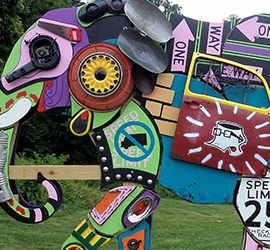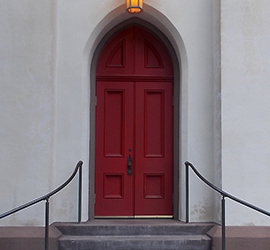Oak Hill Cemetery
I finally made it to Oak Hill Cemetery, in Georgetown. My first stop was the Renwick Chapel or James Renwick Chapel. I was snapping photos when a woman approached me, asking if I would like a tour. (Lucky me! Right place, right time.)
I would soon learn she is the newly established archivist. The tour was short, but we talked long enough for me to want to come back. I won't be coming back alone. I will bring my posse (aka my RPP friends). There is enough history to entice them to Georgetown. Unfortuantely, this trip will have to be for my walkers because they are going to, like me, want to explore and discover. – paerki
From the website: "The cemetery is the final resting place of many well-known politicians, publishers, military officers, diplomats, and philanthropists, who were mostly white. It was founded in 1848 by William Wilson Corcoran, a banker and co-founder of The Riggs National Bank. It's an example of the 19th Century Romantic movement. The cemetery includes Victorian style monuments, including the Oak Hill Cemetery Chapel, which was designed by James Renwick, Jr., the architect of the Smithsonian Building. The Oak Hill Cemetery Historic Preservation Foundation was established in 2003 to preserve and restore the cemetery."
A related journal entry...
March 24, 2021: An Unexpected Find - Yesterday, I took a train to DC with the intention of visiting Rock Creek Park. I was going to hike the Soapstone and Boulder Bridge trails, but had a change of heart.
As the train got me closer to my destination, I could see from my window new buildings and murals, which piqued my curiosity. It was a no brainer for me to adjust my plan, which had me meandering through the city as I created my own walking tour for one.
I walked from the train station to Dupont Circle. From there I walked to sister neighborhoods, reading historical markers and snapping photographs. Ultimately, I got lost (that’s a first).
I continued my journey, hoping I would see a familiar landmark, sign – something. Ultimately, I saw a cemetery. That’s where I needed to be to get myself reoriented. I had to cross a busy highway to get me there, but I made it, unscathed.
Once I crossed the street, I saw a walking path, which led me to a bridge. From there it was an uphill climb on a dirt road. At first, I thought the road was part of the cemetery, but it was not because there was fencing.
I continued on the path when I saw a small marker to the left of me, which I thought was odd. Why would there be a lone grave on the side of a road?
I finally made it to the top! I soon realized there were two cemeteries – one black, one white (that was a cringe-worthy moment). To the left of me was Mt. Zion Cemetery: The Old Methodist Burying Ground / Female Union Band Cemetery (two adjoining burial grounds for the black community) – to the right, Oak Hill Cemetery (for the white community).
The contrast between the two was jarring. To the left of me was an open cemetery in ruins. To the right, a well-loved and well-tended one, shaded by tall trees, sweeping hills and expensive gravestones, and that fence I mentioned earlier.
At this point, I was feeling hungry and parched, so I decided to have lunch at Mt. Zion (I planned on Clyde’s for cocktails and appetizers, but it didn’t fit the mood for the day). I sat on a bench drinking water and eating a granola bar, so I could see Oak Hill (the fenced cemetery) in the distance. I was thinking about life’s contradictions, the false truth narrative. Considering everything going on in the world today, the past is the present and the present will be our future – a strong possibility, if we don’t get our act together. That’s a "Debbie Downer" way of looking at it, but that doesn’t imply I am without hope for a new day. Real change often seems so slow these days, but much of that has to do with people’s fear of the unknown, and their ignorance, too. I am happy not being one of the latter. (I recently read, "without fear there cannot be courage" – perhaps.)
I was right where I needed to be yesterday, in a place of stories. I looked at the broken grave markers at my feet and wondered about the people – who they were, what they did, the challenges they faced, etc. What were their stories, and were they passed down to the next generation? I wonder…
After leaving the cemetery and walking one block, I realized I was in Georgetown. How did I not know?! From Georgetown I walked to the train station. That felt like the longest 3 miles of my life, but in the long run, it’s always worth it.
I appreciate the public art in my everyday life – the diversity of it all, and the scale. I am thankful I can wander with a keen eye, and find places, like the cemetery above, that require me to think in a much deeper way. – paerki
































































































































































































































































